Since 2017, the Venetian walls of Bergamo have become a UNESCO world heritage site and it is from one of its iconic access gates, that of San Giacomo, that your journey to discover their secrets begins among fortresses, embrasures, cloisters and former monasteries…
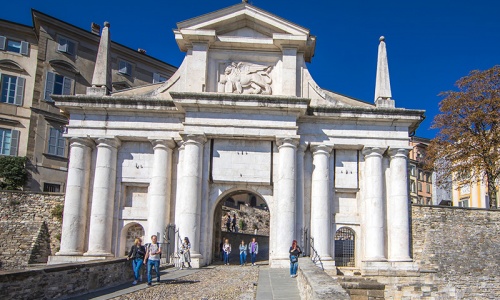
It starts from one of the panoramic points par excellence of Bergamo: San Giacomo Gate, from here, you can enjoy one of the most beautiful views of the Lower Town. It is the only pedestrian access and the only gate to have a facade in Zandobbio marble.
Continue walking around the walls, you will soon see a steel structure placed on a stone support: it is an unusual sundial that marks summer time, solar time and the wind vane. Nearby, you will also find a metal staircase that will lead you to discover the San Giovanni Embrasure, one of the testimonies of the armed defence used during the Venetian domination.
Curiosity: from this stretch of the Walls, during clear days, look carefully and try to spot the skyline of nearby Milan…
It starts from one of the panoramic points par excellence of Bergamo: San Giacomo Gate, from here, you can enjoy one of the most beautiful views of the Lower Town. It is the only pedestrian access and the only gate to have a facade in Zandobbio marble.
Continue walking around the walls, you will soon see a steel structure placed on a stone support: it is an unusual sundial that marks summer time, solar time and the wind vane. Nearby, you will also find a metal staircase that will lead you to discover the San Giovanni Embrasure, one of the testimonies of the armed defence used during the Venetian domination.
Curiosity: from this stretch of the Walls, during clear days, look carefully and try to spot the skyline of nearby Milan…
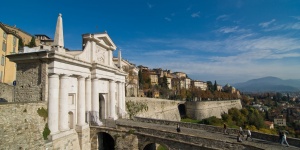
San Giacomo Gate (“Porta San Giacomo”) used to be the entrance to Bergamo for those who came from Milan. It’s the only access to the Walls that can be perfectly seen from Viale Vittorio Emanuele, the axis crossing Lower Bergamo from South to North, both for its position and for its colour. In fact, it is made of white marble extracted from Zandobbio’s quarries, in the near Cavallina Valley: this material makes the gate stand out against the grey defensive walls. Due to these characteristics, besides being one of the most photographed places of Bergamo, it is also an ideal background on which projecting coloured lights during particular events (for instance, the colours of the Italian flag during national celebrations. Lean on the balustrade and enjoy, on one side, a stunning view of the Venetian fortification, and a fantastic panorama of the Lower Town and the Plain up to the Apennines on the other one!
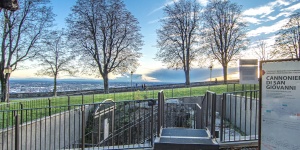
To enter the San Giovanni Casemate you have to go down a few meters under the ground by means of an iron staircase, in the rampart with the same name: this defensive structure was built right here, hundreds of years ago.
Getting to the manoeuvre area of the casemate, perfectly restored, history suddenly becomes something tangible, as you immediately understand what was war like five hundred years ago.
Casemates were used to allocate soldiers and cannons defending the city Walls. As you may notice, the embrasures don’t face the flatland: this is not a mistake, but a strategic choice! The cannons’ openings were guarded against the enemy fire, so that they could open fire to the enemy soldiers assaulting the walls.
Once you got back to surface, you will notice a particular metal object. It’s a sundial, a very ancient tool reinterpreted by using contemporary features and materials: it can almost seem an art installation, indeed!
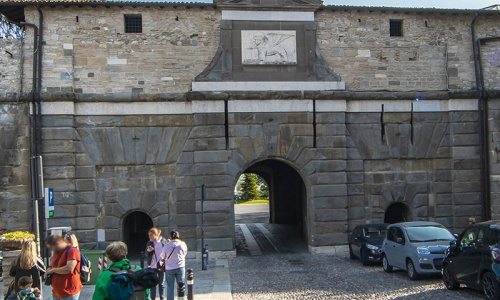
Continue along the path until you reach the top of the Upper Town, where the second gate of the city walls stands magnificently: Sant'Alessandro Gate. Its name is due to the Basilica of the same name of which only one column remains as evidence, try to find it!
Continue staying inside the walls, take Via Beltrami going up slightly and near the Botanical Garden you can admire the San Marco Gunpowder Magazine, a seventeenth-century structure covered in lead once used to store gunpowder. Then, retracing your steps briefly, access the Cittadella Viscontea by following the passage next to the Tower of Adalberto, a characteristic square in the Upper Town which still houses various signs of its variegated past. After the square, locate Via della Boccola following your left: you will find one of the entrances to the former Carmine monastery, today thanks to a cultural redevelopment project by the Tascabile Theatre of Bergamo it offers numerous initiatives and events not to be missed!
Continue along the path until you reach the top of the Upper Town, where the second gate of the city walls stands magnificently: Sant'Alessandro Gate. Its name is due to the Basilica of the same name of which only one column remains as evidence, try to find it!
Continue staying inside the walls, take Via Beltrami going up slightly and near the Botanical Garden you can admire the San Marco Gunpowder Magazine, a seventeenth-century structure covered in lead once used to store gunpowder. Then, retracing your steps briefly, access the Cittadella Viscontea by following the passage next to the Tower of Adalberto, a characteristic square in the Upper Town which still houses various signs of its variegated past. After the square, locate Via della Boccola following your left: you will find one of the entrances to the former Carmine monastery, today thanks to a cultural redevelopment project by the Tascabile Theatre of Bergamo it offers numerous initiatives and events not to be missed!

Sant’Alessandro is the name of the gate facing west, which used to be the main access to the city for those who came from Lecco and Como. Its name comes from the near church dedicated to Bergamo’s patron Saint, destroyed in 1561, as shown by a commemorative plaque located next to the only surviving column, in order to build the Walls. If you cross the gate you can still find the “Sant’Alessandro’s Column”, marking the exact spot where the old cathedral used to be.

Built at the end of the sixteenth century like the one in the valley of Colle Aperto, it is made of sandstone, constructed with an overturned rectangle positioned on top of a pyramid.
Two metres wide and 7 metres tall, the top was covered with lead to ensure water resistance, necessary for the proper storage of gunpowder.
Defence walls and gunpowder storehouses are the only Venetian military structures that have remained intact.
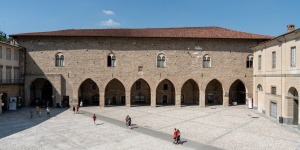
This citadel was built in the most central point of Bergamo: why? To defend the city from the enemies attacks and as a sort of garrison house in case of popular uprising, of course, but also to make sure that the subjects always remembered how powerful their rulers were: the Visconti family, head of Milan’s Duchy and Bergamo’s ruler from 1332 to 1428.
Today, this space has become a typical square in Città Alta and still hosts many traces of its past. Coming from the old town, you will walk under the Torre della Campanelle. On west, you will see a medieval postern gate: once you crossed it you’ll find a roman street (the short paved section right before the cobblestones leading to the postern gate) and you will walk under the Romanesque lowered vaults and the cylindrical pillars belonging to an ancient private house.
As soon as you’ve left the portico, you will find the La Crotta garden, a magical place full of beautiful trees, bushes and paved paths made of rectangular sandstone. The stone benches hidden among the vegetation are there for you: enjoy a romantic break!
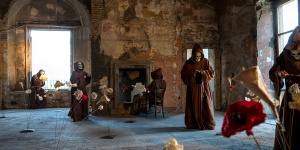
Designed in the first half of the fourteenth century by the Carmelites, it was built between the end of the fifteenth and the beginning of the sixteenth century. In the seventeenth century the stables, the chapter house and a new library were built.
The heart of this majestic structure is the rectangular cloister, with a portico of round arches. The arches are supported by columns with composite type capitals surmounted by pulvini and placed on a low wall. On the first floor, there are architrave loggias.
In the eighteenth century, the monastery entered a period of decline and abandonment and the rooms and cloister were prepared to become apartments for rent. In 1954 it was declared unusable and static consolidation work of the structure began. In recent years, thanks to important restoration work, the monastery has returned to show all its beauty and has rediscovered its place in the fabric of the city.
Today, in fact, it is managed by TTB - Tascabile Theatre of Bergamo, a historic international theatre company, which obtained it under concession from the Municipality of Bergamo. They made it their headquarters, taking care of the place and making it possible to use it for cultural events, shows and concerts.
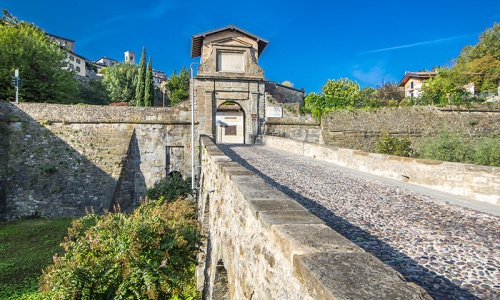
Continuing along Via Boccola, we arrive at the San Lorenzo Gate, opposite to that of San Giacomo, the smallest and oldest of the walls.
Go up Via San Lorenzo, the effort of the small climb will be rewarded by the view of the tallest tower in the city: the medieval Gombito Tower, which today welcomes tourists and visitors from all over the world. Peek into the tourist office and ask for directions to reach Piazza Mercato del Fieno where the former convent of San Francesco is located and discover the panoramic terrace that offers an unmissable view: the crossroads of the two valleys, Brembana and Seriana inside the cloister.
Subsequently, from Piazza Mercato del Fieno, follow Via Solata and then Via alla Rocca until you reach the headquarters of the 19th century Museum: the historic fourteenth-century fortress, the Rocca. Its Remembrance Park is another of the panoramic points not to be missed in the Upper Town!
Continuing along Via Boccola, we arrive at the San Lorenzo Gate, opposite to that of San Giacomo, the smallest and oldest of the walls.
Go up Via San Lorenzo, the effort of the small climb will be rewarded by the view of the tallest tower in the city: the medieval Gombito Tower, which today welcomes tourists and visitors from all over the world. Peek into the tourist office and ask for directions to reach Piazza Mercato del Fieno where the former convent of San Francesco is located and discover the panoramic terrace that offers an unmissable view: the crossroads of the two valleys, Brembana and Seriana inside the cloister.
Subsequently, from Piazza Mercato del Fieno, follow Via Solata and then Via alla Rocca until you reach the headquarters of the 19th century Museum: the historic fourteenth-century fortress, the Rocca. Its Remembrance Park is another of the panoramic points not to be missed in the Upper Town!

Porta San Lorenzo (“San Lorenzo Gate”) used to be the passage to enter the city for those who came from the valleys north of Bergamo and from the countries beyond the Alps.
Its ancient name comes from the church that used to be there, which was demolished by the Venetian Government in order to build the Walls. The second appellation, Porta Garibaldi, derives from a crucial historical event: in June 1859 Giuseppe Garibaldi, leading his volunteers (the Hunters of the Alps) entered in Bergamo right through this gate, setting the city free from the Austrian domination.
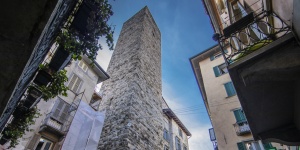
That’s an odd name, indeed! Do you know its origin? “Gombito” is the Italian evolution of the Latin word “compitum”.
However, there are several interpretations about the meaning of “compitum”. Some say it means “crossroad”, as the tower rises in the meeting point between the two main axis of the Roman town, the “decumanus” and the “cardo” (today’s via Gombito and via Lupo). Another argument claims that “compitum” means computare”, “counting”: in fact, the old numbering system of the streets started from here.
The imposing Gombito Tower was built in 1200 as a symbol of power and military hegemony during the struggles between the different city factions: it used to control the access to Piazza Vecchia, the core of Bergamo, from the roads coming from the valleys. Bergamo Administration owns it and opens it to the public in spring and summer: from its top you can enjoy a fantastic view of the surrounding territory!
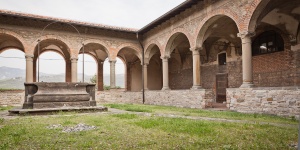
Not far from the heart of the upper town, cross Piazza Mercato del Fieno to discover a fine example of medieval convent architecture, rich in hidden treasures: the Convent of San Francesco.
This enchanting place is also the setting of the Sestini Photography, one of the most technological photography museums in Italy!

From the funicular in the Upper Town, go up Sant'Eufemia hill to reach the Rocca complex, one of the Bergamasco people’s favourite places.
The short walk is well rewarded by the exceptional 360° panoramic view that you enjoy from the tower: in front of your eyes, in addition to the wonders of the Upper Town, you can see the Orobie Prealps and the entire plain, reaching as far as Milan’s skyline.
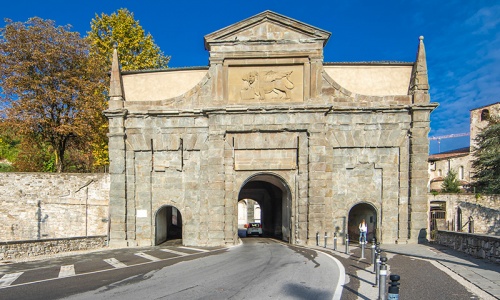
From the Rocca, go to Piazza Mercato delle Scarpe and take Via Porta Dipinta. You go downhill to reach the last stage of the itinerary: Sant'Agostino and the Fara.
Go through the arch of the Sub Foppis gate and enjoy the view of the Fara Park against which the former Sant'Agostino Monastery, now the seat of the University of Bergamo, appears majestic.
Continue in the direction of the former Monastery until you reach the homonymous gate, the main and monumental access to the Upper Town.
Once you have passed the complex, on the right of Viale delle Mura, you will notice an opening that gently goes underground, it is the entrance to the San Michele Bastion: one of the most enchanting places in underground Bergamo, once used for cannons and ammunition, today a cavern entirely decorated with stupendous stalactites and stalagmites.
The itinerary to discover the secrets of the walls ends here, but nothing prevents you from continuing to walk along the walls and be amazed by the views they offer over Bergamo!
From the Rocca, go to Piazza Mercato delle Scarpe and take Via Porta Dipinta. You go downhill to reach the last stage of the itinerary: Sant'Agostino and the Fara.
Go through the arch of the Sub Foppis gate and enjoy the view of the Fara Park against which the former Sant'Agostino Monastery, now the seat of the University of Bergamo, appears majestic.
Continue in the direction of the former Monastery until you reach the homonymous gate, the main and monumental access to the Upper Town.
Once you have passed the complex, on the right of Viale delle Mura, you will notice an opening that gently goes underground, it is the entrance to the San Michele Bastion: one of the most enchanting places in underground Bergamo, once used for cannons and ammunition, today a cavern entirely decorated with stupendous stalactites and stalagmites.
The itinerary to discover the secrets of the walls ends here, but nothing prevents you from continuing to walk along the walls and be amazed by the views they offer over Bergamo!

The former monastery and the ex Church never changed their original purpose: they have been devoted to culture forever.
In fact, this monastic complex established in 1290 by the Eremitani Friars, which then passed to the Observant Friars in 1407 (both belonging to the Saint Augustine Order), soon became the seat of an important centre for religious and cultural research.
In 1647, it began to host the Accademia degli Eccitati, while in 1670 schools of philosophy and theology opened. Today, tradition goes on: the monastery currently houses a branch of Bergamo University, while the ex Church has ben recently restored and it is used as Lecture Hall.
The refurbishment restored the old glory of this ancient gem of Città Alta: from the outside, you can admire the gabled gothic façade in sandstone, along with the Nordic-style round arch entrance portal. Once you stepped inside, you will be amazed by the majestic wood coffered ceiling and by the medieval frescoed walls, enlightened by the wide windows.
Right in front of the ex Church of Sant’Agostino there is the Fara Lawn. When spring comes, this place gets full of people practicing sport, relaxing with friends and enjoying some fresh air. Would you like to join them?
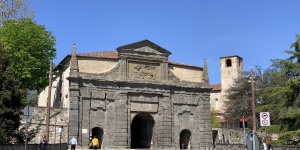
Porta Sant’Agostino has been the main entrance to the Upper Town – Città Alta – for a very long time, both for the inhabitants of Bergamo who went up from Borgo Pignolo and for those who came from Venice. Even today, this passage represents the most commonly used way to move from the Upper Town to the Lower Town and backwards, walking or using public and private transportation.
The Gate was named after the Monastery nearby, which today houses one of the seats of Bergamo University and whose ex-church was recently restored to host the Lecture Hall.
The building of the passage can be dated back approximately to 1575, while the masonry arches on which the Venetian Chief Magistrate Alvise Contarini built the access street lies on in 1780, to replace a wooden drawbridge.
On the opposite side of the street, aligned with the middle entrance, a fountain was realized uphill the Gate, making the access to Città Alta even more beautiful. The street that we call Viale Vittorio Emanuele was build in 1838, on the occasion of the visit of the Austrian Emperor Ferdinand I: it goes up from the centre of the city to the ancient district of Borgo Pignolo, right in front of Sant’Agostino Gate. Not far from this monumental passage you can also find the Noca pedestrian street, which allows you to reach very quickly the Accademia Carrara, one of the most important Italian picture galleries.
Trivia: like the other gates of the Walls, every night at 10 Sant’Agostino Gate used to be closed to guarantee the city’s safety.
Since September 2024, Porta Sant'Agostino is home to the "Mura di Bergamo" (Walls of Bergamo) museum, part of the Museum of the Histories of Bergamo network and a significant step in the enhancement of the Venetian Walls, a UNESCO World Heritage site since 2017.
Through numerous historical testimonies and multimedia stations, the exhibition will showcase the stages of the fortress's construction, from design to physical construction, taking you on a journey through time made even more exciting by the fact that you will find yourself at the heart of that very fortress.
The centrepiece of the exhibition is the immersive room, where the history of the Walls is narrated through the voices of its protagonists. Surrounding it are four dramatic sections that broaden knowledge of the monument by placing it within wider contexts: the territorial defensive system of the Republic of Venice, the architectural culture of the Italian Renaissance that invented the "modern fortresses," and the military revolution of 16th-century Europe. The final stop, but certainly not the least interesting, is the part dedicated to the fortress’s construction site during the years of its building (1561-1588), brought to life by descriptive and scenic elements.
A visit not to be missed, inside the Walls still throbbing with life.
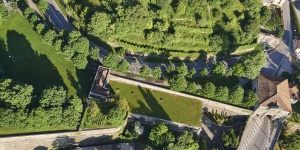
The Venetian Walls are one of the most famous fortresses built by Venice. They were built to defend the Western border of the Venetian Republic, while the Eastern border was defended by the fortress in Famagosta, on the island of Cyprus.
No battles were ever fought here. From the 19th century on, the bastions and ramparts have been a favourite walkway. The best way to see the walls and enjoy the impressive historical buildings and beautiful landscapes is on foot.

The Fara rampart and meadow are located next to the St. Agostino rampart, near the St. Agostino Gate, at the eastern end of the Upper Town walls. The rampart is part of the fortifications built in the XVI century by the Venetian Republic to protect Bergamo, today a UNESCO site, and together with the Fara curtain wall it defended the area between the St. Agostino and St Lorenzo ramparts.
Today it is a panoramic and much-loved part of the strolls along the walls, thanks to the tranquillity of the area and the presence of many places where people can relax.
More internally, just in front of the former St. Agostino Church, there stretches the Fara meadow, once and for a long time an inaccessible area. Here in fact was what the Bergamo people called "fupù", a big pit in the ground then filled, during the 1930s, with the debris from abandoned and irrecoverable Upper Town buildings, demolished as part of the consolidation project started by engineer Luigi Angelini.
Today, luckily, this meadow is a meeting place for many people: as soon as the warm season comes, the area is full of sportsmen, groups of friends and families wishing to spend time outdoors. What are you waiting for? Come join them!